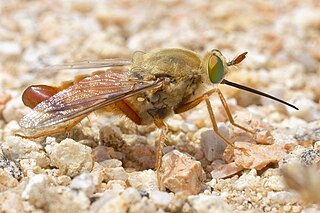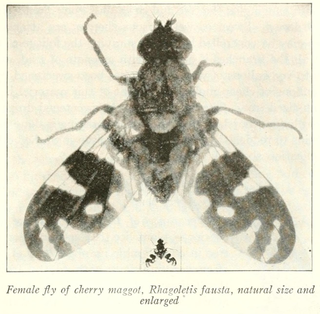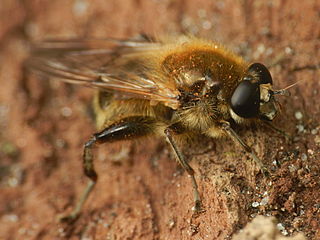
The mydid fly genus Rhaphiomidas contains fewer than 30 species/subspecies, all of them occurring in the desert regions of the southwestern United States and adjacent portions of northwestern Mexico. The adults are most commonly encountered in sand dune areas, and are typically only active for a few weeks each year, either in the spring or the fall; in some cases, more than one species can occur in the same dune system, but they are allochronic, each flying in different seasons. Almost nothing is known about their biology, though eggs or early instar larvae of some species are laid on the soil surface and appear to be attractive to ants, and are brought into the ant nest. The restriction to sand dune areas has unfortunately led a number of these flies to the brink of extinction, especially both subspecies of R. terminatus, and the species R. trochilus. While there is only one of these on the Endangered Species List, many of the remaining taxa - including a few that have not yet been named - are gravely imperiled, as they are restricted to small geographic areas, rendering them extremely vulnerable to habitat loss or disturbance. These habitats are heavily targeted for development, and even if not, activities such as sand mining or motorized off-roading are common, and render the habitat unsuitable for the survival of the flies.
Brennania is a genus of flies in family Tabanidae. It was originally known as Comops, created as a subgenus of Apatolestes by Brennan (1935). Philip (1941) then raised it to genus level, but renamed it to Brennania.
Procecidocharoides is a genus of tephritid or fruit flies in the family Tephritidae.

Rhagoletis fausta, the black-bodied cherry fruit fly, is a species of tephritid or fruit flies in the genus Rhagoletis of the family Tephritidae. It is found in the United States and Canada.

Scellus is a genus of flies in the family Dolichopodidae.

Brachypalpus is a genus of hoverflies, from the family Syrphidae, in the order Diptera. The head is triangular and produced well forwards and somewhat downwards. The thorax and abdomen with pile often rather long. The hind femur is swollen and with an obtuse spur apically and ventrally. The hind trochanters of male is spurred.
The larvae are of the rat-tailed type feeding on decaying sap under tree bark. Larvae live in decaying trees and logs. Larva and pupa have been described by Malloch.
Eutreta diana is a species in the family Tephritidae, known as fruit flies in North America and picture wing flies in Europe. Females lay eggs in vegetative buds of several species and subspecies of sagebrush in western North America. Larvae induce woody galls near their oviposition site and feed on the plant internally until they mature. Adults have "pale green eyes, white-dotted black wings, and bright red abdomens". Growth of galls coincides with spring seasonal growth of sagebrush. There is one generation per year.
Boreothrinax is a genus of flies in the family Pyrgotidae.
Hybomitra procyon is a species of horse flies in the family Tabanidae.
Adoxomyia rustica is a species of soldier flies in the family Stratiomyidae.
Rachicerus honestus is a species of fly in the family Xylophagidae.
Caloparyphus is a genus of flies in the family Stratiomyidae.

Turbopsebius is a genus of small-headed flies in the family Acroceridae. There are about four described species in Turbopsebius.
Brachypalpus alopex, the Bumblebee Catkin Fly, is an uncommon species of syrphid fly first officially described by Osten Sacken in 1877. Hoverflies get their names from the ability to remain nearly motionless while in flight. The adults are also known as flower flies, for they are commonly found around and on flowers from which they get both energy-giving nectar and protein-rich pollen. The larvae are of the rat-tailed type feeding on decaying sap under tree bark.
Ocnaea is a genus of small-headed flies. There are 20 described species in Ocnaea.

Eulonchus sapphirinus is a species of small-headed flies in the family Acroceridae.
Sphecomyia brevicornis is a species of syrphid fly in the family Syrphidae.

Sphecomyia is a genus of hoverfly in the family Syrphidae. There are about 16 described species in Sphecomyia.
Caloparyphus crotchi is a species of soldier fly in the family Stratiomyidae.

Hypocritanus is a genus of hoverfly found in the Neotropical region.








